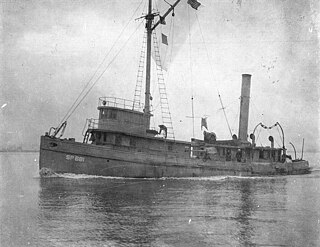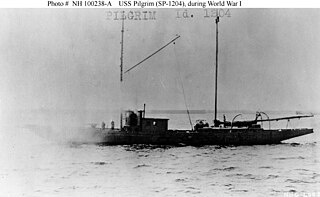
USS Hobcaw (SP-252) was a United States Navy patrol vessel, towing boat, and ferryboat in commission from 1917 to 1918.
USS Wilbert A. Edwards (SP-315), sometimes called USS W. A. Edwards, was a United States Navy patrol vessel in commission from 1917 to 1919.
USS Aramis (SP-418/PY-7) was a yacht acquired by the United States Navy during World War I which served as a patrol boat off New York City, was then fitted with an experimental "underwater detection system" and depth charges as an anti-submarine vessel, and was briefly the flagship of a battleship squadron. She ended her career as a tender and houseboat to a survey vessel off the coast of Cuba, until disposed of in 1933.
USS R. W. Wilmot (SP-604) was a United States Navy patrol vessel in commission from January to April 1918.

USS Katie (SP-660) was a United States Navy patrol vessel in commission from 1917 to 1918.

USS Breakwater (SP-681) was a United States Navy patrol vessel, minesweeper, and tug in commission from 1917 to 1920.
The first USS Ibis (SP-3051), also listed as USS Ibis (ID-3051), was a United States Navy minesweeper in commission from 1918 to 1919.
USS Lexington II (SP-705), later USS SP-705, was an American patrol vessel in commission from 1917 to 1918.

USS Sapphire (SP-710) was a United States Navy patrol vessel in commission from 1917 to 1918.

USS See W. See (SP-740) was a United States Navy patrol vessel in commission from 1917 to 1919.
USS Itasca II (SP-803) was a United States Navy patrol vessel in commission from 1917 to 1918.
The second USS Wissahickon (SP-852), which also served as USS SP-852, was a United States Navy patrol vessel in commission from 1917 to 1918.
USS Jolly Roger (SP-1031) was a United States Navy patrol vessel in commission from December 1917 or early 1918 until November 1918.
USS Wego (SP-1196), also spelled We-go and We Go, was a United States Navy patrol vessel in commission from 1917 to 1918.
USS Hunch (SP-1197) was a United States Navy patrol vessel in commission from 1917 to possibly 1918.

The third USS Pilgrim (SP-1204) was a United States Navy patrol vessel in commission from 1917 to 1919.
USS Herreshoff No. 308 (SP-2232), also written Herreshoff #308, was a United States Navy patrol vessel in commission from 1918 to 1923.
USS Herreshoff No. 321 (SP-2235), also written Herreshoff #321, was a United States Navy patrol vessel in commission from 1918 to 1921.

USS Vaud J. (SP-3361) was a United States Navy patrol vessel in service from 1918 to 1919.
USS Estelle (SP-747), later USS SP-747, was a United States Navy patrol vessel commissioned in 1917 and stricken in 1933.








